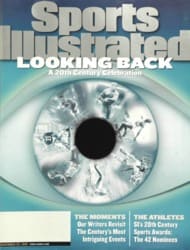
Inside The White Lines JULY 6 1957 ALTHEA GIBSON WINS WIMBLEDON
A white man took a black woman's hand, two tennis champions at a
summer dance. Few witnessed the event, and nobody wrote about
it. All the champs did was perform a two-step and improve the
world--or at least one timeless and beautiful spot in it. This
was at Wimbledon, in the summer of '57, two months before nine
black kids tried to enter Central High in Little Rock only to
find a group of Arkansas National Guardsmen blocking the door,
on the orders of the Arkansas governor, Orval E. Faubus. All the
newsmen were camped out there in Little Rock. I'd have taken the
dance instead. The Wimbledon men's champ in 1957 was Lew Hoad, a
dashing Australian. The ladies' champ was Althea Gibson. Althea,
the groundbreaker.
The 29-year-old Gibson knew the customs of the All England Club.
She knew about the strawberries, the white-only tennis outfits,
the proper protocol upon meeting the queen. For the fortnight of
the tournament she was staying in the West End flat of a friend,
Angela Buxton, a Jewess, as they said in London in those days. A
year earlier, in '56, Buxton and Gibson had won the doubles
title at Wimbledon. The Jewess and the colored girl, they were a
curiosity, but most Britons were too polite to fuss over them
much more than that. At the '57 tournament, though, Buxton was
injured and unable to play. Instead, she designed Gibson's
tennis outfits, all white, of course, which suited Gibson just
fine, since white showed off her smooth, dark skin and her
torch-singer good looks. The outfits were mostly shorts or
divided skirts; she needed clothes in which she could move.
Gibson was one of the favorites at Wimbledon in 1957. The
previous year she had won the French Open, her first major
title. One is tempted to say that, at 29, she was at the peak of
her powers, but it is hard to know. It wasn't until 1950, when
she was 23, that the United States Lawn Tennis Association
allowed Gibson to become the first black player to participate
in the U.S. Championships at Forest Hills. She had spent her
Harlem youth often riding the subways all night to avoid her
drunken father's beatings and playing paddle tennis during the
day on 143rd Street. She came to "proper" tennis late. A group
of Harlem businessmen had paid Gibson's way to London.
It was a sound investment. Gibson made the net her personal
property, overheads were automatic points, and she didn't lose a
set. She played with an athleticism never before seen in women's
tennis. She was Venus and Serena a generation before Papa
Williams had his first tennis vision for his yet unborn
daughters. In the semifinal Gibson trounced a popular English
schoolgirl named Christine Truman 6-1, 6-1. The bursting Centre
Court crowd cheered lustily for the loser, because she was
English and because she was the underdog. In the evenings after
her matches Gibson returned with Buxton to the flat, where
Gibson relaxed with a string of cigarettes and whiskeys and
slept practically until match time.
In the final, in 90[degree] heat, Gibson defeated a Californian,
Darlene Hard, 6-3, 6-2 in 50 minutes. Gibson "was the first
representative of the Negro race ever to win a Wimbledon
[singles] title," but, as SPORTS ILLUSTRATED reported at the
time, the fans at Centre Court "raised only an apathetic cheer
when the Queen presented her with a big gold salver and Darlene
hugged her with sisterly enthusiasm." Gibson played a masculine
game, and the English didn't know how to respond to it. For
Americans, of course, winning is the thing, and she returned as
a public icon, to a ticker-tape parade down Broadway. (Today,
though, Gibson rarely talks publicly about her Wimbledon
victory, or anything else.)
Only a couple of months after Gibson's Wimbledon victory, the
forced integration of Central High in Arkansas turned into a
violent, ugly spectacle. At the All England Club that summer,
integration had come about naturally and cordially. During the
Wimbledon Ball, after the two champions danced and before the
final toast was raised, Gibson took the bandleader's microphone
and sang, in her deep and sultry voice, I Can't Give You
Anything but Love. She was now a member of the All England Club:
An honorary membership comes with the singles title. She was, as
far as anybody knows, the first black woman to be a member.
Nobody cared. Or if people did, they pretended not to.
It is naive to think that you could write a story about two club
members--both tennis champions, one black, the other
white--sharing a dance and that such a story could influence the
thinking of the likes of Orval E. Faubus. But I would love to
have tried.
In the summer of '58 Gibson came back and won Wimbledon again,
and in time the black kids in Little Rock walked through the
front door at Central High, just like everybody else. Talent had
won out again, and so, finally, had reason. In some immeasurable
way, Miss Gibson must have helped us get there.
COLOR ILLUSTRATION: ILLUSTRATION BY MILTON GLASER Gibson's momentous win in England proved a harbinger of change in the U.S.
At the All England Club that summer, integration had come about
naturally and cordially.

